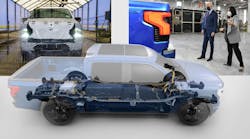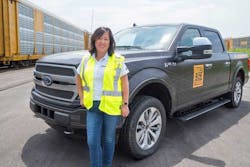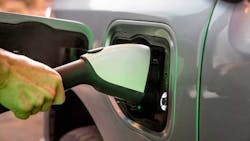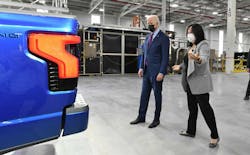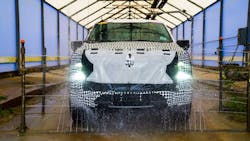This article is part of TechXchange: Women in Science and Engineering
This article appeared in Machine Design and has been published here with permission.
What you'll learn:
- Linda Zhang, chief nameplate engineer behind Ford’s all-electric F-150 Lightning, has a 25-year career with the automaker.
- When the F-150 Lightning launches in 2022, it will be replete with special features, including a bi-directional charger, an inverter and a home management system that keeps the lights on for about three days.
- The all-electric pickup can reach 60 mph in 4.4 sec., making it quicker than its gas-powered counterpart.
- Emissions-free electric cars come with a promise of reducing their carbon footprint. Ford reports more than $11.5 billion in investments in electric vehicles through 2022.
There’s a story overlap with what Linda Zhang cares about and what the Ford Motor Company’s priorities are for its all-electric F-150 Lighting pickup truck. Zhang’s career and the success of the electrification project are inextricably tied.
Zhang was only 19 when she joined the automotive company after completing a degree in electrical engineering in 1996. “For a long time, I kept that really quiet because I was always worried that people were going to think that I was too young or too immature,” Zhang said.
Today, leading the charge on ensuring the reliability and ingenuity on Ford’s best-selling pickup truck for 44 years, those misgivings have been waylaid.
As the chief nameplate engineer behind Ford’s all-electric F-150 Lightning , Zhang’s role is to lead the planning and electrification effort of the iconic truck. In a nutshell, she sets up the product for success by bringing everyone together. “I work with all of the team members, whether it’s the engineers that engineer the parts, the designers that make the beautiful products or the manufacturing team,” she said.
Being able to strategize on what goes under the hood of the first all-electric F-Series workhorse in time for its rollout in 2022 is not only a rare opportunity, but being first also allows for innovation in the relatively untapped electrification space. “As more companies make the commitment to go carbon neutral, they are going to expect electric products that can integrate into their operations easily,” said Jim Farley, president and CEO, Ford Motor Company, in a press note.
For Zhang and her team, the challenge of delivering a zero-emissions pickup is an exciting feat. There were those who were skeptical about its potential, as electric is not typically equated with capable. “One of the key turning points for us was our ability to demonstrate that capability with not only the basic acceleration, but also tough things like towing and hauling,” said Zhang, who sat behind the wheel of a prototype in 2019 to tow 10 double-decker freight cars (weighing more than a million pounds):
F-150 fans will recall the stunt couldn’t get by skeptical gearheads, who pointed out the illusion was made possible by the principle of rolling resistance coefficients. In other words, the force and friction needed to tow the freight trains a distance of 1,000 feet were considerably lower than would have been required for towing vehicles on road tires. Spectacle aside, the demo showed that an electric truck had the ability to haul “far beyond any production truck’s published capacity,” noted Ford.
When the F-150 Lightning launches in 2022, it will be replete with special features. “Delivering content such as the intelligent backup power will prove to be a major delight because it fixed a huge pain point for customers,” said Zhang. Drivers will be able to opt for the bi-directional Ford Charge Station Pro, plus an inverter and a home management system that will function as a 9.6 kW power source that keeps the lights on for about three days.
Then there’s the Mega Power Frunk, which is basically a watertight front trunk with 400 lb of payload, and it comes with four 120-volt AC electrical outlets and two USB ports. It is also fitted with a one-way drain to makes quick work of cleanups.
Speed and Range
As significant as unveiling the F-150 Lightning is for changing the EV segment is the auto industry’s lofty goal of overhauling combustion engine plants and switching to electric. GM, Jaguar, Bentley, Cadillac, Mini and Volvo are among those promising all-electric production by 2030.
The shift signals measurable progress. Emissions-free electric cars come with a promise of reducing their carbon footprint. Ford reports more than $11.5 billion in investments in electric vehicles through 2022, including the zero-emission Mustang Mach-E and the fully electric F-150. The company boasts of being on track to power its manufacturing plants with 100% locally sourced renewable energy by 2035, with the ultimate goal of reaching carbon neutrality by 2050.
Yet, going electric involves a lot more than going green. Consider sticker shock: EVs cost more than equivalent gas-powered cars, despite technology advances. A partial explanation is that carmakers spend billions designing new EV models, but initial sales amount to a mere fraction of traditional car sales, report analysts. Earning back their investments will take time. EVs accounted for about 2% of the U.S. new-car market, and represents only about 17% of the world’s total stock of 10.2 million EVs, according to the Pew Research Center. Ford reports the F-150 Lightning will start at $39,974 but can be optioned all the way up to $90,000.
Another consideration is that range anxiety (fearing the EV won’t have enough charge to reach the destination) has long been a hurdle to large-scale EV adoption. On average, Americans drive about 30 miles a day, according to the AAA Foundation for Traffic Safety and the Urban Institute. Most EVs can go more than 200 miles on a full charge, while gasoline vehicles have a range from 400 to 500 miles.
Could those anxieties fade with offerings like the F-150 Lightning? Targeting 563 horsepower and 775 lb.-ft. of near instantaneous torque, the pickup offers options of either a standard range battery targeting 230 miles of EPA-estimated range or an extended-range battery targeting 300 miles of EPA-estimated range. The vehicle’s intelligent range system uses an adaptive monitoring system to calculate battery range needed to complete a trip. The data then synchronizes with cloud-based features so drivers can plan routes and monitor charge.
“We leverage the battery to provide electrical power output for our customers, whether it’s on the go with our [four 120-volt electrical outlets onboard] so that they can plug things in one plug at a time, or whether it’s at home, allowing the truck to serve as a backup generator for the entire home ecosystem in case of any power outages,” explained Zhang. “There are many other capabilities that electrification can bring, and that’s what we’re doing.”
The all-electric pickup can reach 60 mph in 4.4 sec., making it quicker than its gas-powered counterpart. EVs provide instant power and there are no gears to shift. President Joe Biden realized this fact when he seized the chance to test drive the F-150 Lighting Pro during an unscheduled stop at Ford’s Rogue Electric Vehicle Center in Dearborn, Michigan on May 18. “This sucker’s quick,” commented the president.
Power, Value, and Capability
No doubt, along the path to meeting the standards and rigor that drivers have come to expect of the F-150 series, a few kinks needed to be addressed. For instance, Zhang and her team faced some challenges sizing the batteries, the motors, and the cooling system when they first started working on the product. “We did experience some failures there, particularly with tough work, like going uphill,” she said.
Motivated by her team’s accomplishments, Zhang said she is excited about the future of electrification. In her view, the F-150 electrification project is not only an inflection point for her employer, but also a tipping point for EV adoption for the industry.
The Bipartisan Infrastructure Framework endorsed by President Biden includes plans to build a national network of 500,000 EV chargers along highways and in rural and disadvantaged communities.
Regardless of any gains made, Ford and Zhang both have their work cut out. The infrastructure needed—whether it’s home charging or public charging—will remain a challenge for EV adoption initially.
“We’ve done a lot of really great work to try to mitigate [charging concerns] with the home chargers that come with the product,” Zhang said. The rollout of the fleet next year will be supported by a network of 644 electric vehicle-certified centers across the U.S.
“My job here isn’t done yet,” said Zhang. “We’re still in the final stages of testing and verification and we also have a really important manufacturing-launch phase coming up with the truck. So, my plan is to stay with this truck throughout this next big phase.”
Fortunately, the project is unfolding in a white space, so Zhang and her team have the freedom to innovate and try different things. “Whenever you attempt innovation, you’re always going to get some level of failure,” reflected Zhang. “That failure also helps us learn and with that level of innovation you can’t be afraid to fail. But it’s not really the failure that matters. Instead, it’s how we react to it that matters the most.”
